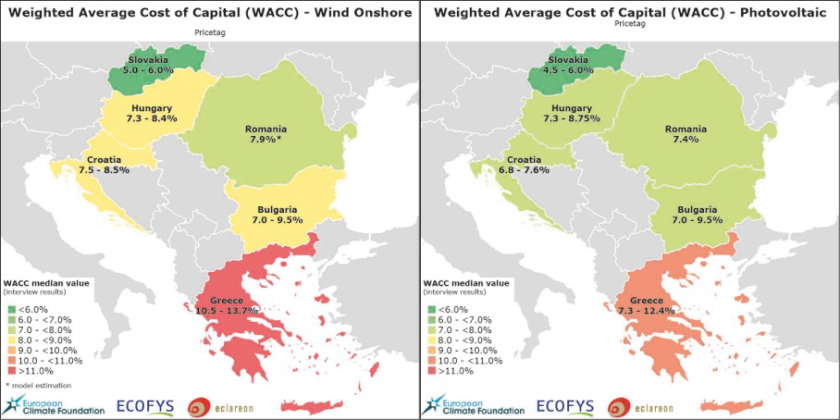
Photo: Pricetag report
Investments in wind and solar energy in Southeast Europe did not increase even though the cost of capital decreased in 2014-2016, which is why stable policy schemes have to be designed at European and national level, according to the “Pricetag” study funded by the European Climate Foundation.
The “Pricetag” project examined the cost of capital of on-shore wind and solar energy in Bulgaria, Greece, Croatia, Romania, Hungary and Slovakia. The study was led by the firm Ecofys, research in Croatia was conducted by Starfish Energy, while Ecofys and Eclareon explored other regional markets.
“We were quite surprised – in most markets, there has not been any wind power development, despite decreased cost of capital for such projects,” says Robert Brückmann from Eclareon.
Over 2014-2016, the weighted average costs of capital (WACCs) have decreased for all economic investments, due to the policies of the European Central Bank and national central banks. The cost of borrowing for corporations fell by approximately 30 percent. However, investments into wind and solar power have not increased, the study finds.
The main reason for the high cost of capital in Croatia is the instability of policies for promoting RES, such as the delay in the implementation of measures under the Law on renewable energy sources and highly effective cogeneration, which replaces the current system of incentives with premiums, but which has not been implemented in practice.
The problem in Bulgaria is the abolition of previously approved feed-in tariffs and the introduction of grid access fees for the producers of solar and wind energy. In the case of Romania, the study says that primary and secondary legislation suffered major changes every six months since 2013/2014.
The WACC figures for solar investment are generally lower than the capital cost for wind onshore. The WACC for PV investments in Bulgaria, Croatia, Hungary and Romania are relatively similar (between 6.8 and 9.5 percent), the Slovak Republic has again much lower values (4.5 to 6 percent), whereas Greece has much higher WACC than the other markets (7.3 to 12.4 percent). The trend of low WACC for PV investments has been observed also in other European markets (such as Germany or France).
The cost of capital for wind onshore ranges in autumn 2016 between 5-6 percent in Slovak Republic up to 10.5-13.7 percent in Greece. Except for these two countries, there is a strong consistency between the markets explored in this report: The WACC figures for Bulgaria, Croatia, Hungary and Romania vary between 7 percent and 9.5 percent.
An earlier study conducted by Ecofys compared the WACC of all EU member states for wind power, and found that it was lowest in Germany (3,5-4,5 percent), France (5,7 percent), Great Britain (6,5 percent), Austria (6,5 percent), Denmark (5-6,5 percent), the Benelux (5-6,7 percent), and Finland (6-7 percent).
The European Commission warned that investments are increasingly concentrated in a few member states with low cost of capital and policy frameworks perceived as more stable. UK and Germany alone represented over two thirds of all investments over 2013-2015.
In most South-East European Member States, renewable energy markets have yet to be further developed, while relying on good RES potential.


















Be the first one to comment on this article.